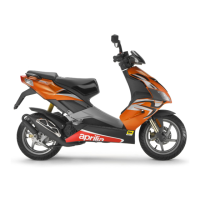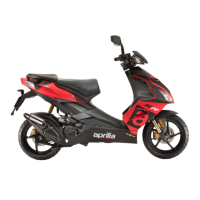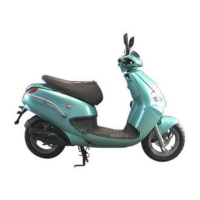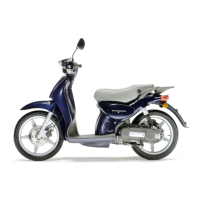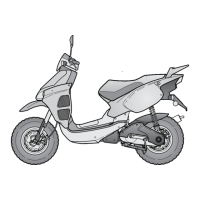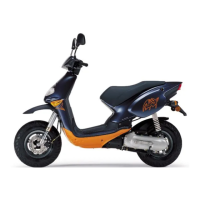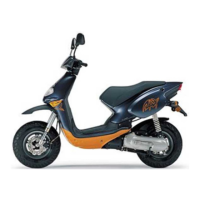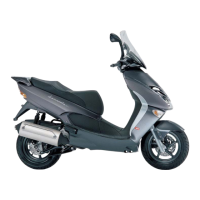Do you have a question about the APRILIA RALLY 50 and is the answer not in the manual?
Covers legal requirements, learning the vehicle, and choosing safe areas for initial rides.
Highlights the impact of medication, alcohol, drugs, and fatigue on driving safety.
Emphasizes the importance of experience, lending rules, and adherence to traffic signs.
Advises on avoiding abrupt movements and considering road surface and visibility.
Guidance on avoiding obstacles, slipstream riding, and maintaining correct posture.
Minimizing driver distractions and the importance of using correct fuels and lubricants.
Procedures for checking vehicle damage after an accident and contacting a dealer.
Prohibits changes to vehicle parts like lights, indicators, and engine power.
Details loss of insurance and legal sanctions for unauthorized vehicle tampering.
Advice against participating in races and riding off-road.
Guidance on proper helmet use, protective clothing, visibility, and fit.
Advises against carrying dangerous objects in pockets during rides.
Owner responsibility for accessories, avoiding function impairment and ensuring secure fastening.
Precautions against electrical overloads and recommendations for genuine accessories.
Principles for balancing load, securing luggage, and maintaining the center of gravity.
Guidance on not placing bulky items on handlebars or helmets on strings.
Instructions on securing bags, avoiding protrusions, and respecting weight limits.
Diagram and key for identifying the primary components of the vehicle.
Locating and understanding the function of controls on the handlebars.
Explains the meaning of warning lights, speedometer, odometer, and fuel level gauge.
Details on horn, cold start lever, and turn signal switch operations.
Explanation of the start push button functionality.
Operation of the key for ignition, locks, and compartment access.
Step-by-step procedure for locking the steering mechanism.
Instructions for unlocking, lifting, and securing the vehicle saddle.
Details on the under-seat storage capacity and purpose.
Location, access to battery/tools, and compartment capacity.
Proper use of the bag hook and its weight limit.
Handling inflammable fuel, safety during refueling, and tank capacity.
Function of mixer oil, reserve indicator, and topping up procedure.
Fluid issues, handling precautions, environmental disposal, and dealer contact.
Importance of front brake, fluid change, disc brake, and reservoir location.
Procedure for checking fluid level and adding brake fluid.
Measuring lever travel and using the adjuster to set brake clearance.
Importance of correct pressure, checking tyre wear, and damage.
Using correct tyre types, valve caps, and professional servicing advice.
Explanation of how the headlights automatically turn on with the engine.
Warning about hot surfaces and proper engine operation for converter efficiency.
Importance of pre-ride inspections to ensure safe operation.
Steps for electric starting, safety warnings, and oil light indication.
Steps for kick starting the engine and associated safety warnings.
Procedures for starting the engine after a long period of non-use.
Guidance on getting underway, mirror adjustment, and throttle control.
Proper braking techniques, slowing for turns, and handling slippery conditions.
Importance of engine break-in, recommended road types, speed, and throttle limits.
Methods for stopping the vehicle and turning off the ignition switch.
Safe parking on a stable surface and correct use of the centre stand.
Using the steering lock, parking securely, and keeping documents in order.
Purpose and correct usage of the anti-theft hook for securing the vehicle.
Safety measures including engine cooling, part handling, reassembly, and protective gloves.
Where to find the engine number and its significance for identification.
Where to find the frame number and how to access it by removing a cover.
Steps for removing the air cleaner, including safety warnings and clamp replacement.
Instructions for cleaning the filter element, drying it, and applying oil.
Procedure for checking and topping up the transmission oil level.
Recommended intervals and procedure for changing transmission oil.
Step-by-step instructions for safely removing the front wheel.
Instructions for correctly reinstalling the front wheel, including torque specs.
Procedure for safely removing the exhaust silencer, including cooling precautions.
Instructions for removing the rear wheel, including silencer removal and nut change.
Frequency, steps, and precautions for greasing the rear brake cam pin.
How to inspect front brake pad wear and when replacement is needed.
How to inspect rear brake shoe wear and when replacement is needed.
Procedure to detect and address looseness in the steering system.
Procedure to check engine mount tightness and address any slack.
Steps to remove the inspection cover for access to internal components.
Steps to remove the front handlebar fairing, with handling precautions.
Procedure for setting the correct idling speed and related precautions.
Procedure to set the correct play in the throttle control cable.
Checking condition, gap, cleaning, and replacement of the spark plug.
Checking battery level, terminals, and safe handling of electrolyte.
Steps to preserve battery health when the vehicle is unused for extended periods.
Procedure for checking electrolyte level and safely recharging the battery.
Safety, checking, and replacing blown fuses with correct types.
Instructions on how to adjust the headlight beam direction accurately.
Safety and handling guidelines before changing any vehicle bulbs.
Step-by-step instructions for replacing the vehicle's headlight bulbs.
Steps for replacing the front turn signal indicator bulbs.
Steps for replacing the rear turn signal indicator bulbs.
Instructions for replacing bulbs for warning lights and dashboard illumination.
Steps for replacing the vehicle's rear light bulbs.
Precautions to take before transporting the vehicle, including fluid drainage.
Procedure for emptying the fuel tank and carburettor components.
Recommended cleaning techniques, material handling, and safety precautions.
Steps to store the vehicle properly for extended periods to preserve its condition.
Procedures for checking and preparing the vehicle after a period of storage.
Specifications for vehicle dimensions like length, width, height, and weight.
Details on engine type, displacement, bore/stroke, compression, and cooling.
Specifications for transmission, wheel sizes, tyre types, and inflation pressure.
Details on ignition, battery, bulbs, and fluid capacities.
List of approved lubricants and fluids for various vehicle components.
Visual representation of the vehicle's electrical system circuitry.
Key to identifying electrical components and understanding wire colours.
Emphasis on the importance of using original Aprilia spare parts.
Company thanks and advice on responsible vehicle use and environmental disposal.
| Fuel System | Carburetor |
|---|---|
| Rear Suspension | Single shock absorber |
| Front Brake | Disc |
| Rear Brake | Drum |
| Cooling | Air |
| Transmission | Automatic |
| Front Suspension | Telescopic fork |
| Engine | Single cylinder, two-stroke |
